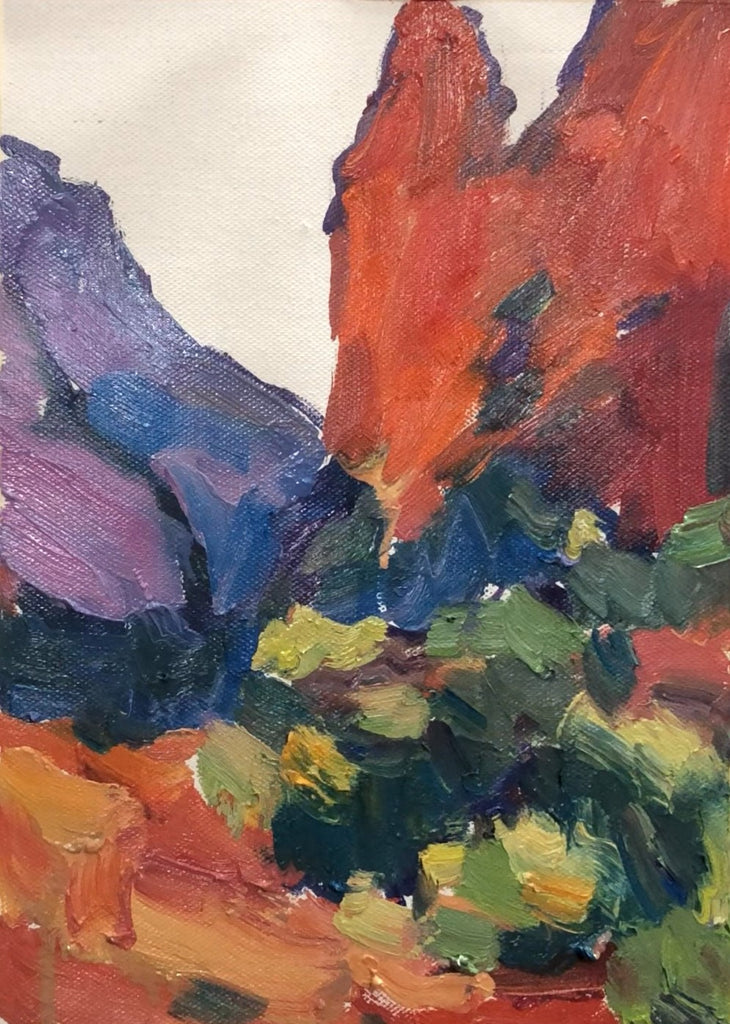Landscape painting can be a great way to show off your creative skills and to capture the beauty of nature in a painting. Creating a landscape painting can be a fun and rewarding experience. With the right tools and techniques, you can create a beautiful painting that captures the natural beauty of the outdoors. In this blog post, I will show you how to paint landscapes with brushes and palette knife.
Canyon of the Ancients National Monument Spring Morning
15x11 inches
- Choose your subject matter carefully. When painting a landscape, it's important to select a scene that is both visually appealing and challenging. Don't be afraid to experiment with different subjects, such as mountains, forests, or lakes.
- Study your subject matter carefully. Once you have chosen a location, take some time to study the surroundings. Notice where does the sunshine from or the way the trees move in the wind.
-
Sketch the landscape
In order to sketch a landscape onto the canvas, you will need a pencil, and maybe an eraser.
When you're ready, begin by sketching the outline of the scene. Be sure to include all the important features, and don't worry about the details yet. Once the outline is finished, start adding some important elements in the details, such as shadow of the trees and hills, the shape combination of the mountain, the stones on the ground, and the direction of the hillside. Don’t add too many details, we will use oil paint to complete the details next.
Once the pencil sketch is done, you can outline it with a dark oil paint mixed with a generous amount of turpentine. This step can correct the unsatisfactory parts of the pencil draft. You can also smear out the dark shadows. In this painting, the morning sun is warm, and I used a bluish dark gray as the outline and shadow color.
Take your time and don't be afraid to experiment. The most important thing is to have fun and to enjoy the process.

-
Paint the base color thinly with brushes
You must first carefully observe the overall layout and tone characteristics of the selected landscape. In this landscape, the warm morning sun turns the sky creamy. The sun light is not yet strong, and the mountains in the distance look a bit gray. The nearby trees are gradually becoming clear, but the green is not very strong in the morning fog.
This is done by tempering the paint with turpentine into a thin color. I recommend using the largest bristle brush. You don't need to paint too many details, just paint the general color tendency of each object. Note that I kept the shadows and most of the outlines from the previous step.
Use a variety of brush strokes. When painting a landscape, use a variety of brush strokes to create depth and texture. Try to create the illusion of movement by using quick, short strokes for the sky and long, sweeping strokes for the ground.
Use complementary colors. Complementary colors are colors that are opposite each other on the color wheel. When used together, they create a visually appealing effect. For example, blue and orange are complementary colors, so when painting the orange mountains, I used dark and gray blue as the shadow color.

-
Wait for the underlying paint to dry.
I use the wet-on-dry oil painting technique, which is more controllable than the wet-on-wet technique. Generally, it takes 7 days for the surface of the paint to dry, and the time required for cold or wet weather will be extended. -
Add details with brushes and a palette knife
For objects that don't need too strong strokes, such as distant mountains and shadows of trees, I will use a bristle oil brush to add details. Note that the distant scenery should be drawn briefly, because of the influence of air scattering, the distant object has only a blurred image. If it is too detailed, it will run to the front of the picture. Nearby objects, such as soil slopes and trees, need to be painted in more detail with strong brushstrokes. I use a painter's knife loaded with a lot of oil paint to paint them. Especially where the light hits, thick paint is required to create the feeling of light jumping.
Texture is an important part of any landscape painting, as it can add interest and depth to a scene. You can add texture to a painting by using a variety of brushstrokes. Different brushstrokes can create different textures in a painting. It’s a good idea to add rich texture to the painting by using a palette knife.
Using a palette knife requires different techniques. For the large area of the soil slope, I used the method of smearing, and for the highlights of the trees, I just placed thick and bright paint lightly on them.

-
Make some minor adjustments to the oil painting




